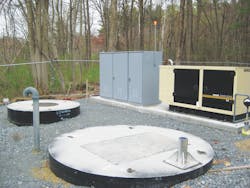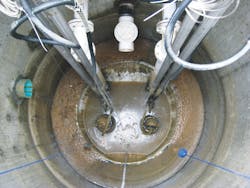TOPS Lift Stations in Haverhill, MA
The city of Haverhill, MA, a community of 68,000, shares much in common with the sewage infrastructure of other long-established New England municipalities. Unfortunately, not only does Haverhill share much of the same infrastructure, it has been plagued with the same frequent, costly clogging issues.
Project or Scope
Haverhill’s collection system consists of 35 pump stations along more than 987,000 linear feet of 8- to 72-inch gravity pipe and 4- to 42-inch force mains. More than 143,000 linear ft. of the collection system originated in the late 1800’s and included over 295,000 linear feet of combined sanitary and storm waterlines.
“The combination of a prefabricated station and self-cleaning pump offers a proactive solution to prevent clogging.”
Of the 35 stations, 17 are flooded suction stations, six are vacuum primes and four are air-ejector type stations. The remaining eight stations are fitted with electric submersibles — one of those serving several area restaurants. The problem for the wastewater utility was that these restaurants would plug the sump monthly with grease buildup. It would take three men with a pump truck four hours or more to pull the original pump at the station and clear it. Haverhill needed to solve the chronic clogging at this location, and they would use that experience in the planned construction of four new and one replacement stations.
Solution
Haverhill retrofitted the pump at the problem location with a Flygt N-impeller to control the grease. The solution cut clogs from a monthly (and sometimes weekly) occurrence, to a once-a-year issue at most. Pleased with this success, the city made the self-cleaning Flygt brand N-Pump their preferred specification. Soon, Flygt included the N-Pump as a major component of the prefabricated TOPS (“The Optimum Pump Station”) lift station. Haverhill chose the TOPS station as a fully integrated solution for the five new projects.
The 6-ft. dia. lift stations were largely assembled at grade level, lowered into 15-ft deep holes and then grouted into place. The convergent slope of the sump floors encouraged incoming solids and other debris to settle into a trough molded into the bottom of the fiberglass insert. This improved suction power at the pump inlet and self-cleaning volute of the pump itself. The combined design features optimize the fluid handling of a lift station, especially those facilities with high solids and debris in their flows. The twofold design features inherently eliminate “dead zones” where sludge can build up in non-agitated areas of traditional flat-bottom wetwells.
“The TOPS concept offers improved performance along with simplified procurement and installation.”
Result
With the factory-manufactured TOPS package, the facilities overcame the clogging experienced at many traditional site-built, cylindrical wetwells whose flat circular bottoms are prone to collect built up sludge and odorous surface blanket scum.
While it is too early to quantify the cost benefits of fewer clogs, the TOPS stations delivered other impressive benefits.
The TOPS concept simplified procurement because the fiberglass inserts, pumps, sealed wall penetrations, required fittings, mounting hardware, vent pipe, level and pump station controls were all supplied by a single source. In addition, the contractors who assembled, set into place and grouted the new stations cited the easier installation, reduced completion schedules and clog-resistant design as major initial and long-term benefits of the prefabricated concept. With virtually no clogging or snarled impellers expected, the pumps will operate at full efficiency and use up to 40 percent less energy than their traditional counterparts.
Editor's Note: Scranton Gillette Communications and the SGC Water Group are not liable for the accuracy, efficacy and validity of the claims made in this piece. The views expressed in this content do not reflect the position of the editorial teams of Water & Wastes Digest, Water Quality Products and Storm Water Solutions.

